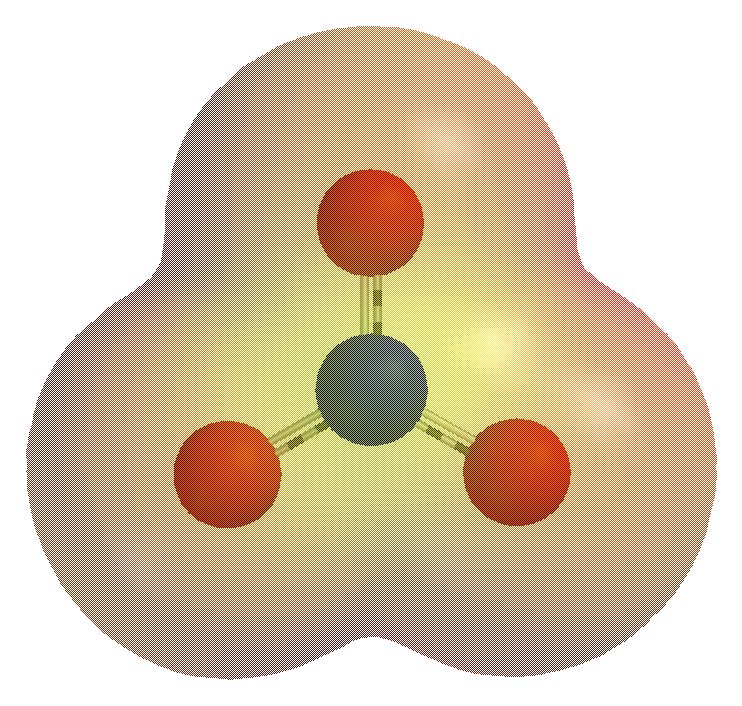Molecules Will Continue to Spread Out Until 8

Ions are charged atoms or molecules. They may have a plus charge, a minus charge or – rarely – both. Examples of each are the positive sodium ion (Na+1 ), the negative bisulfate ion (HSO4 -1 ) and the glycine zwitterion (or dipolar ion) (H3N+1‐CH2‐C(O)2 -1 ). Spreading the electric charge will stabilize both positively and negatively-charged ions – but how does this work?
Charge and Nature
Even as "nature abhors a vacuum," it likewise abhors a concentrated electric charge – lightning well illustrates this point.
Although ordinary table salt exists in water solution as charged ions, those ions are not isolated as the above shorthand symbols would indicate.
The ions are stable in water because the charge is spread out or diluted, as it were, spreading the charge over the water molecules. Consider what happens when a single crystal of salt is placed in a beaker full of water.
Atomic Polarity
Water molecules (H2O) behave as if they have a small charge, which, in fact they do. This is because the oxygen atom in a water molecule does not have its hydrogen atoms attached at opposite sides of the oxygen atom. Rather, looking the water molecule resembles the head of a mouse with its two small ears, they are off center.
The side of the water molecule with its center between the two hydrogen atoms carries a small positive charge. The other side – away from the hydrogen atoms – carries an equivalent, small negative charge. Thus a water molecule has two poles, or oppositely charged centers.
Dissolving an Ionic Solid
Some water molecules tend to point their negative side toward sodium atoms at the crystal surface. Other water molecules join in with their positive or hydrogen atom-bearing sides tending to line up with electron-rich chlorine atoms. These fluid water molecules pull at these atoms, successfully breaking them away from the crystal. Water molecules surround the ions.
Interestingly, a sodium ion surrounded by water molecules points the hydrogen atoms outward to form a kind of cage of hydrogen. The positive charge can be shared with each and every one of these hydrogen atoms (thus, spreading charge), so the charge per hydrogen is really quite small. Charge spread stabilizes the ion.
A similar, even though seemingly opposite, event occurs in the case of chlorine. Since the chloride ion is negative, it draws the positive, hydrogen-rich part of a number of water molecules, exposing only the hydrogen-poor oxygen ends outward, as its charge cage. The oxygen atoms each can carry some of the chlorine ion's negative charge, so the charge per atom is really quite small. Again, charge spread stabilizes the ion.
Organic Chemistry – Hydroxyl versus Water as Leaving Group
Many organic chemistry reactions involve ions. Sometimes the ion is a positive carbocation (also called a carbonium ion). Depending upon the structure, such ions, with their charge on carbon, may rearrange, putting the charge on a hydrogen atom within the molecule. Quite generally, it is not a positive hydrogen atom or a negative hydroxyl ion that leaves in most organic reactions – they are termed "poor leaving groups." The explanation as to why may be given in terms of charge and acidity or basicity.
Consider a reaction example: the bromination of methyl alcohol. Not considering the reaction mechanism, the overall reaction is
CH3OH + H‐Br → CH3Br + H‐OH
The question is, does hydrobromic acid break apart and the bromide ion react in this fashion:
CH3OH + Br-1 → CH3Br + OH-1 ?
No, it does not. Instead, the reaction is said to proceed in this fashion:
H–Br + CH3OH → [Brδ-–CH3–OH2 δ+]→ CH3–Br + H2O
where the positive and minus are partial, rather than full charges.
Notice that the positive charge on the leaving group is spread out over two hydrogen atoms, until it disappears altogether. This is another example, albeit somewhat disguised, in which charge spread stabilizes an ion.
Charge Spread and Ion Stabilization
Spreading charge stabilizes ions by decreasing the "concentration" of the charge in any one spot. This is a phenomenon that takes place in many solutions, in everything from saltwater to chlorine-water.
Note: You might also enjoy Acids, Bases, Salts: Can an Oxide be a Salt?
References:
- Canagaratna, M. ACS Publications: Structure and Bonding of the Sulfamic Acid Zwitterion. (1996). Journal of Chemical Education
- Dewick, P. Essentials of Organic Chemistry. (2006). Wiley
← Back to Quirky Ideas
← Home
Source: https://www.quirkyscience.com/spreading-electric-charge/
0 Response to "Molecules Will Continue to Spread Out Until 8"
Post a Comment